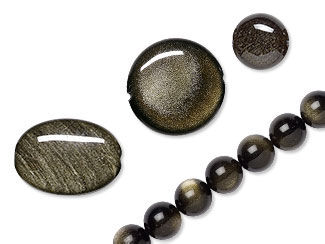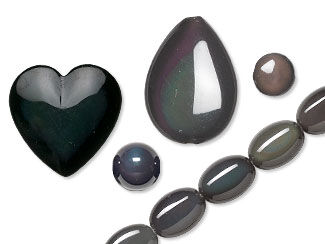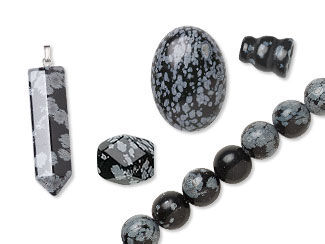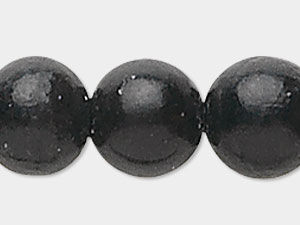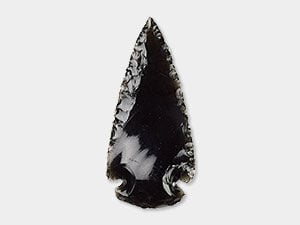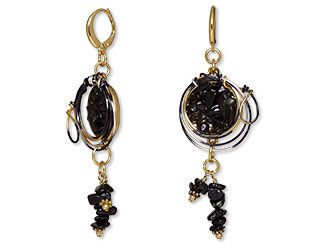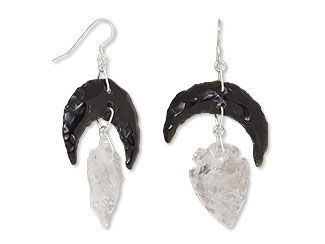Obsidian, Black Meaning and Properties
Black Obsidian History
Obsidian, a naturally occurring volcanic glass, has been used as a gemstone since antiquity. Formed when lava rich in feldspar and quartz cools too rapidly for crystals to form, obsidian is not classified as a true mineral. This is because its composition is too variable and, as a glass, it lacks a crystalline structure, distinguishing it from other igneous rocks.
Obsidian, named after the Ancient Roman explorer Obsidius, who discovered it in Ethiopia, has been prized for both its beauty and utility throughout history. Its shiny, glass-like surface made it ideal for creating early mirrors in ancient Mesopotamia, Central America and Europe. Beyond its decorative appeal, obsidian's lack of cleavage and ability to fracture into sharp, smooth edges made it invaluable for crafting surgical blades, arrowheads , knives, spears, jewelry, statuettes and writing tablets. From the Stone Age to medieval times, cultures across the world—including Native Americans—utilized obsidian for hunting, warfare and various practical applications, recognizing it as the sharpest natural cutting material available.
Learn more about obsidian’s unique qualities and metaphysical benefits in this informative video.

What are the Metaphysical Properties of Black Obsidian?
Black obsidian is said to be a powerful grounding stone known for its ability to shield against negativity and provide strength. It purports to help stabilize emotions, absorb negative energies and promote emotional healing by confronting hidden truths and deep insecurities, fostering spiritual growth. Black obsidian meaning is associated with removing energy blocks and bringing new life to a person’s goals. Black obsidian meaning is also tied to physical benefits, such as relieving pain, calming the nervous system and supporting those suffering from depression or addiction.
What Chakra is Black Obsidian?
Chakras are considered energy centers that influence the body, mind and spirit. The root chakra, located at the base of the spine, is tied to grounding, protection and inner strength. Chakra bracelets offer a minimalist, wearable way to stay connected to these energies throughout the day. Black obsidian, a volcanic glass known for its sharp clarity and powerful presence, is aligned with the root chakra. Wearing black obsidian is believed to anchor your energy, shield against negativity and foster a deep sense of stability and self-possession.
Root Chakra (Muladhara) - Red
- Location: base of spine in the coccyx or tailbone area
- Represents: foundation of self; grounding energy; survival instincts; physical needs (including financial stability); food
- Emotional issues: safety
- Spiritual issues: security
- Physical issues: associated with reproductive system; adrenal system; food or satiety
- Gemstones: bloodstone, garnet, obsidian, smoky quartz
What is Black Obsidian Made From?
Obsidian can be found wherever volcanic activity has occurred, with some of the most notable sources today being South America, Japan, Mexico and parts of the United States. However, it is present on every continent, including Antarctica. This hard, brittle and glossy volcanic glass is renowned for its exceptionally sharp cutting edge, which is nearly five times sharper than highly refined steel and at least ten times thinner than a razor blade.
- Mineral Information: Volcanic, amorphous, siliceous glass
- Chemical Composition: SiO2 (75%) with MgO and Fe3O4
- Color: Black
- Hardness: 5 to 5-1/2 (Mohs)
- Specific Gravity: 2.4 – 2.6
- Refractive Index: 1.45 – 1.55
How Do You Clean Black Obsidian?
Black obsidian is considered a durable material and can be safely cleaned using a soft cloth and soapy water. Soap residue can build up on it, so rinse well and polish after. As with most gemstones, ultrasonic cleaners and steamers are not recommended. Take care to store obsidian in a soft case away from hard objects as it can be easily scratched.
Black Obsidian FAQ
Q: Is black obsidian a true gemstone or a type of volcanic glass?
A: Being a glass, black obsidian lacks the crystalline structure of a true gemstone.
Q: Where in the world is black obsidian commonly found?
A: Black obsidian is found all over the world, on every continent, including Antarctica. It is associated with volcanic activity.
Q: Why is black obsidian usually so smooth and shiny?
A: Black obsidian is smooth and reflective due to its origin as natural volcanic glass. Unlike crystalline minerals, it forms when lava cools so quickly that no crystal structure can develop, resulting in a sleek, glass-like surface.
Q: Does black obsidian always appear jet black or can it have other colors or inclusions?
A: Pure obsidian is black, sometimes with a velvety green sheen, but if it has inclusions it may glow with shades of red, gold, brown, ultraviolet or even white speckles.
Read more about other varieties of obsidian.
Q: How can a designer use black obsidian for a bold look in jewelry designs?
A: Black obsidian is naturally bold, with is midnight black color and high-gloss shine. Showcase black obsidian beads with gold-, silver- or copper-toned metals for a high-contrast, big-impact showpiece. It’s also the perfect centerpiece for striking pendant necklaces, fierce cuff bracelets or eye-catching cocktail rings.
Designing with Black Obsidian
Black obsidian's versatility and unique appearance make it an excellent choice for a wide range of jewelry styles, from bold and elaborate to simple and elegant. Because black obsidian is brittle, it is better suited for smaller jewelry pieces like earrings and brooches, which are less prone to the wear and tear that necklaces and bracelets often experience.
Black obsidian beads are popular in necklaces, bracelets, and anklets, where their smooth, polished surface adds a sleek and sophisticated touch, making them perfect for both casual and formal designs .
The bold appearance of black obsidian makes it perfect for statement pieces like large pendants, cuff bracelets or cocktail rings. Its dark color creates a striking contrast when set in silver, gold or other metals, making the jewelry stand out.
For those who prefer understated elegance, black obsidian works well in minimalist jewelry designs. Simple black obsidian studs, thin band rings with small black obsidian accents or delicate chain necklaces with black obsidian drops are examples of how this stone can be used in subtle yet stylish ways.
Black obsidian is often used in men’s jewelry, such as cufflinks, tie bars, rings and bracelets, due to its strong, masculine appearance. Its dark, glossy finish is particularly appealing in designs that aim for a bold, classic look.
Shop for Black Obsidian
A Few Design Inspirations to Get You Started
**Please note that all metaphysical or healing properties listed are collected from various sources. This information is offered as a service and not meant to treat medical conditions. Fire Mountain Gems and Beads® does not guarantee the validity of any of these statements.
How did you like this resource? Your feedback helps us provide resources that matter to you most.
Copyright Permissions
All works of authorship (articles, videos, tutorials and other creative works) are from the Fire Mountain Gems and Beads® Collection, and permission to copy is granted for non-commercial educational purposes only. All other reproduction requires written permission. For more information, please email copyrightpermission@firemtn.com.

